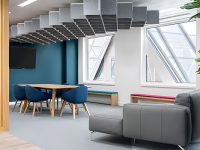Noise Control in Office Fitouts: Acoustic Solutions That Work

Modern office spaces are designed to be open, collaborative, and flexible. While these layouts promote teamwork and creativity, they can also come with a significant challenge: noise. Excessive sound can disrupt concentration, increase stress, and reduce productivity – that’s why smart acoustic planning is essential in any workplace design. Many businesses, as seen in Office Fitout Brisbane’s projects, are incorporating innovative noise control solutions to create work environments that balance openness with comfort.
Why Noise Control Matters in Offices
Noise is one of the most common complaints in open-plan offices – conversations, ringing phones, and office equipment can easily become distractions. Poor acoustics not only make it harder for employees to focus but can also impact communication during meetings or confidential discussions. Addressing these issues through acoustic design creates a more productive and enjoyable work environment.
Acoustic Solutions That Make a Difference
There are several effective strategies that can be integrated into office fitouts to manage sound levels and improve overall comfort:
1. Acoustic Panels and Baffles
Installing wall-mounted or ceiling-hung acoustic panels helps absorb sound waves and reduce reverberation. These come in a variety of materials, colours, and styles, allowing them to blend seamlessly with modern office aesthetics.
2. Soundproof Partitions
For areas requiring more privacy, such as meeting rooms or breakout spaces, soundproof partitions are an excellent solution. They provide separation without compromising design flow, helping reduce noise transfer between spaces.
3. Acoustic Flooring and Carpeting
Hard surfaces reflect sound, but acoustic flooring and carpets absorb it. Choosing materials designed for sound insulation significantly reduces footsteps, movement, and general background noise.
4. Furniture with Acoustic Properties
Innovative office furniture now incorporates built-in acoustic features, such as high-backed booths or pods designed for quiet focus work or private calls. These provide adaptable, sound-controlled spaces within open-plan offices.
5. White Noise Systems
In some environments, white noise machines or sound masking systems can help by covering distracting background sounds with a consistent, neutral noise. This can be particularly effective in large workspaces.
Integrating Acoustic Design from the Start
The most effective approach to noise control is to consider acoustics at the early stages of office fitout planning. By integrating sound management into layout, materials, and furniture choices, businesses can ensure their workplaces are not only visually appealing but also conducive to focus and collaboration.
Acoustic comfort is no longer a luxury in office design—it’s a necessity
By implementing practical solutions such as panels, partitions, flooring, and smart furniture, businesses can create workplaces where employees thrive. Whether you’re upgrading an existing office or planning a new space, making noise control a priority will pay dividends in productivity and staff satisfaction.







